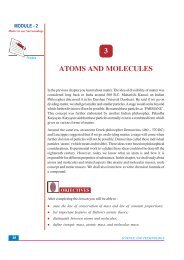19. Classification of Living Organisms
19. Classification of Living Organisms
19. Classification of Living Organisms
You also want an ePaper? Increase the reach of your titles
YUMPU automatically turns print PDFs into web optimized ePapers that Google loves.
MODULE - 5<br />
The <strong>Living</strong> World<br />
Notes<br />
<strong>Classification</strong> <strong>of</strong> <strong>Living</strong> organisms<br />
pond, river, oceans, and mountains, deserts etc. Various kinds <strong>of</strong> organisms or different<br />
species live in these ecosystems. They interact with each other and also interac with the<br />
physical components <strong>of</strong> the ecosystem such as light, temperature etc.<br />
Read the following table and perform the accompanying activities.<br />
Table <strong>19.</strong>1 Biosphere, ecosystem and species<br />
Level <strong>of</strong><br />
Organisation<br />
Images/ pictures <strong>of</strong> each<br />
level<br />
Diversity <strong>of</strong><br />
features<br />
Activity<br />
Biosphere<br />
the physical part <strong>of</strong><br />
earth on which<br />
organisms can<br />
survive<br />
Fig. <strong>19.</strong>1a Earth as seen<br />
from space<br />
Oceans,<br />
mountains, fresh<br />
water bodies,<br />
forests, snow clad<br />
areas, deserts and<br />
grasslands.<br />
Obtain an outline<br />
map <strong>of</strong> the world<br />
and mark in<br />
different colours,<br />
the diverse<br />
components<br />
mentioned in the<br />
adjacent column.<br />
Ecosystem<br />
Definite<br />
geographical region<br />
in which various<br />
species <strong>of</strong><br />
organisms live and<br />
interact with each<br />
other and the<br />
physical<br />
environment<br />
Fig.<strong>19.</strong>1b Ecosystem<br />
Oceans,<br />
mountains, rivers,<br />
ponds, forests,<br />
snow-clad areas,<br />
deserts etc.<br />
Collect pictures or<br />
read from your<br />
geography book or<br />
see a website to<br />
rec ord specific<br />
features <strong>of</strong> the<br />
ecosystems<br />
mentioned in the<br />
previous column.<br />
Species<br />
Group <strong>of</strong> very<br />
similar organisms<br />
which can<br />
interbreed to<br />
produce fertile<br />
<strong>of</strong>fspring.<br />
Different kinds <strong>of</strong><br />
bacteria, protozoa,<br />
fungi, plants and<br />
animals<br />
Collect pictures <strong>of</strong><br />
humans belonging<br />
to different parts <strong>of</strong><br />
the world. They<br />
look different.<br />
Why are they said<br />
to belong to the<br />
same species?<br />
Fig. <strong>19.</strong>1c Species<br />
<strong>19.</strong>1.2 Levels <strong>of</strong> biodiversity<br />
All the varieties <strong>of</strong> living organisms on earth constitute biodiversity. Three levels <strong>of</strong><br />
biodiversity have been recognized:<br />
1. Ecological/Ecosystem diversity<br />
<strong>Organisms</strong> evolved features which helped them adapt to their surroundings or the<br />
ecosystems in which they live. There are different ecosystems and even related<br />
organisms living in different ecosystems may differ vastly from each other. For<br />
4<br />
SCIENCE AND TECHNOLOGY
















